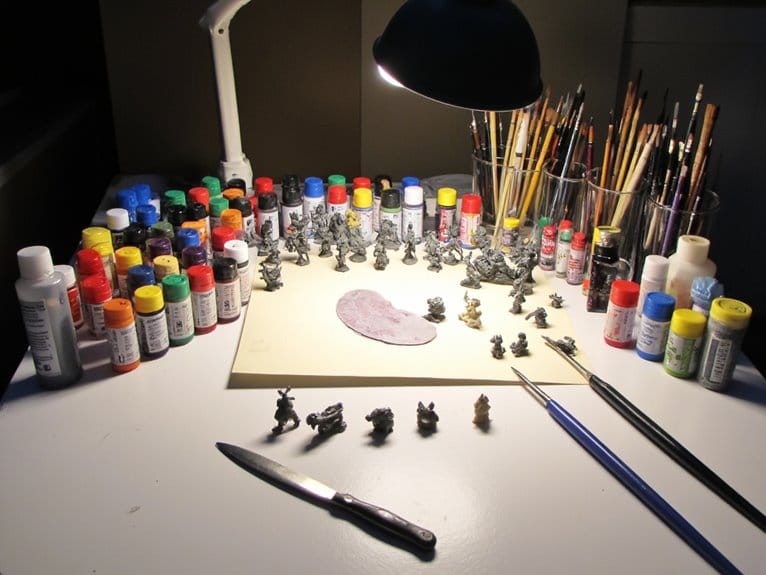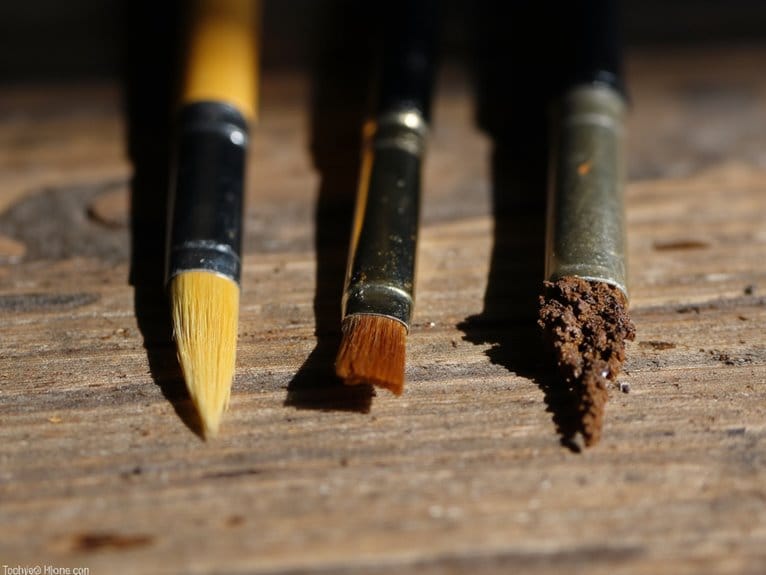We are supported by our audience. When you purchase through links on our site, we may earn an affiliate commission, at no extra cost for you. Learn more. Last update on 1st July 2025 / Images from Amazon Product Advertising API.
When painting white cloth, I recommend starting by applying a light gray undercoat to enhance shadows and highlights realistically. Utilize precise dry brushing techniques to add depth and dimension, along with strategic highlighting using white paint for a lifelike finish. Remember to focus on creating shadows and gradually build up the whitest areas with thin layers for precision. Enhancing shadows and tones is essential, as well as customizing effects and experimenting with different shades to achieve a visually appealing outcome. Mastering these foundational techniques is vital for painting white cloth convincingly.
Choosing the Right White Paint
When selecting the ideal white paint for painting white cloth, opt for a high-quality satin or matte finish to achieve a realistic texture. The finish plays a significant role in how the final piece will look, giving it the appearance of actual fabric. Make sure to choose a white paint that offers smooth application and good coverage. This is vital for achieving a professional-looking result without streaks or uneven patches. Investing in a high-quality white paint will make a notable difference in the final outcome of your miniature painting.
Additionally, look for white paints specifically designed for miniature painting. These paints are formulated to meet the needs of intricate details and small surfaces, ensuring excellent results when painting white cloth on miniatures. Another key aspect to take into account is the mixability of the white paint with other colors. Opt for a white paint that is easy to blend with different shades to create custom colors and unique blends for your cloth textures. Experiment with various brands and types of white paint to find the big one that works best for your painting style and preferences. Testing out different options will help you determine the perfect white paint for your miniature painting projects.
Applying a Gray Undercoat
When preparing to paint white cloth, selecting the appropriate shade of gray for the undercoat is essential for capturing realistic shadows and highlights. Applying a consistent base coat guarantees a smooth foundation to enhance the texture and details of the fabric. Priming the surface with a gray undercoat before adding white paint is vital to achieve a vibrant and uniform finish.
Choosing the Right Shade
To achieve a realistic shadow and depth when painting white cloth, it is essential to apply a light gray undercoat as a foundation for the white paint to enhance its vibrancy and adherence. The benefits of using a gray undercoat include creating a nuanced look and allowing for easier layering of white paint, resulting in a smooth finish. When choosing the right shade of gray for the undercoat, opt for a light tone to prevent darkening the white cloth excessively. This guarantees that the white paint maintains its brightness and purity. Selecting the appropriate shade of gray is pivotal for achieving ideal color contrast and depth in the final painting, providing a solid base for the subsequent layers of white paint to shine.
Applying Even Base Coat
For optimal results in painting white fabric, the initial step involves applying a smooth and even grey base coat to provide a neutral foundation that enhances the adherence and vibrancy of the white paint. When applying the grey base coat, it is essential to guarantee a thin, even layer to allow for easy highlighting and shading later on. Blending techniques can be utilized to create seamless shifts between colors, while texture application can add depth to the fabric. Selecting the right brush for the base coat is vital to achieve a consistent finish. Understanding base coat variations and color theory can assist in creating the desired effect for the white fabric, establishing the groundwork for a successful painting process.
Importance of Priming
Priming with a gray undercoat plays a fundamental role in enhancing the vibrancy and realism of the white cloth painting process. Color psychology suggests that using gray as a base creates a neutral foundation, allowing the white cloth to appear more vivid and true to its intended hue. Texture application becomes more manageable with the undercoat, as it provides a surface for seamless shading and highlighting, resulting in enhanced depth and lifelike qualities. The benefits of the undercoat extend to ensuring a smoother canvas for the white paint, reducing the risk of uneven coverage. Moreover, subtle shadows and intricate fabric details are accentuated, contributing to a more authentic portrayal of the cloth. Ultimately, the gray undercoat optimizes efficiency by requiring fewer layers of white paint for full opacity and coverage.
Utilizing Dry Brushing Technique
Utilizing the dry brushing technique on white material involves applying a gray undercoat first to establish a base for the subsequent white paint. The textile texture plays a vital role in this technique, as the raised areas will catch the white paint, creating highlights that mimic the natural interplay of light on material. When dry brushing, precision is key in highlight placement. Focus on the edges and folds of the material to enhance its three-dimensional appearance.
Layering depth is achieved by loading a dry brush with white paint and lightly dragging it over the raised portions of the material. It’s crucial to use a gentle touch and gradually build up the white paint to control the intensity of the highlights. By carefully blending the white highlights with the base color, a seamless shift is created, enhancing the textured look of the white material.
To master the dry brushing technique on white material, practice is key. Experiment with different brush pressures and amounts of paint to perfect the art of highlighting with this method. By paying attention to fabric texture, highlight placement, and layering depth, you can achieve a realistic and visually appealing finish on your painted white material.
Highlighting With White Paint
To enhance the realism and texture of white cloth in a painting, employing the right brush stroke technique is essential. By strategically applying layers of white paint to raised areas and folds, one can achieve a depth that breathes life into the fabric. The use of light is paramount, as it helps create smooth shifts and prevents harsh edges, resulting in a natural play of highlights on the cloth.
Brush Stroke Technique
When highlighting white cloth with paint, employ precise, controlled brush strokes along raised areas to enhance depth and texture. To achieve the desired effect, consider the following techniques:
- Experiment with different brush sizes to vary the thickness of the highlights.
- Use a dry brush technique for a soft, subtle highlight.
- Try stippling or dry brushing for a textured look.
- Layer white paint gradually to build up intensity and avoid overloading the brush.
- Blend the white paint with the base color using gentle strokes for seamless blending.
Layering for Depth
Layering white paint strategically over a base coat of cool gray-blue on the cloth is key to achieving depth and luminosity in highlighting. When highlighting with white paint, focusing on creating realistic highlights by gradually building up from the base color is crucial. Here are some tips to enhance your painting technique:
- Textured finish: Utilize layering techniques to add texture and dimension to the cloth.
- Gradual buildup: Start with a light hand and gradually increase the white paint intensity for a realistic highlight effect.
- Attention to detail: Concentrate on edges, folds, and areas where light naturally hits for a lifelike look.
- Smooth blending: Blend the white paint seamlessly into the base color to avoid harsh transitions.
- Patience and precision: Practice steady hand movements and patience to achieve a seamless and realistic layering effect.
Building up Whitest Areas
Gradually applying thin layers of white paint is essential to build up the whitest areas on the cloth with precision and smooth coverage. When focusing on building up these areas, blending techniques play a pivotal role. By blending the white paint carefully, you can guarantee a seamless shift between different shades, avoiding any harsh lines that may disrupt the overall look of the cloth. Highlighting tips are also important during this process. Concentrate on highlighting raised areas and folds to add dimension and realism to the cloth. This will help in creating a more lifelike appearance as light naturally hits these areas.
Layering effects are achieved by applying multiple thin layers of white paint. This technique allows you to control the intensity of the color and build up the desired opacity gradually. When considering shadow placement, remember that shadows contribute significantly to creating depth. By strategically placing shadows in areas that would naturally be darker, you can enhance the three-dimensional effect of the cloth.
Moreover, depth creation involves customizing effects to suit the specific texture of the cloth you are painting. Utilize a fine detail brush to add precision to the whitest highlights, ensuring that each stroke contributes to the overall realistic portrayal of the fabric. By following these techniques, you can effectively build up the whitest areas on the cloth, resulting in a beautifully painted piece with depth and dimension.
Adding Depth With Contrast Paint
Utilizing contrast paint strategically on the white cloth enhances the shadows and depth within the intricacies of the folds and creases. When adding depth with contrast paint, several key techniques can be employed to achieve a realistic and visually appealing effect:
- Consider Light Sources: Think about where the light is coming from and apply the contrast paint accordingly to create shadows that align with the light direction.
- Experiment with Blending: Use a damp brush to blend the contrast paint seamlessly, softening any harsh lines and creating a smooth shift between light and shadow.
- Explore Texture Techniques: Vary the application of contrast paint to enhance the texture of the fabric, emphasizing different areas to add dimension.
- Play with Color Theory: Experiment with different colors of contrast paint to find the perfect balance between shadows and highlights, enhancing the depth of the white cloth.
- Master Shading Techniques: Practice controlling the amount of contrast paint applied to achieve the desired level of depth and definition in the fabric texture, ensuring a realistic finish.
Creating Shadows and Tones
To enhance the realism of the white cloth painting, it’s essential to master shadow placement techniques. By skillfully blending light and dark tones, one can create depth and texture on the fabric. Utilizing a light touch and layering technique will help achieve a nuanced and lifelike representation of shadows and tones.
Shadow Placement Techniques
When painting white cloth, strategically placing shadows on the underside of folds enhances the depth and dimension of the fabric, creating a more realistic appearance.
- Use a light gray or cool blue shade for shadow placement along creases and seams.
- Consider the light direction to guarantee consistency and realism.
- Gradually build up shadows with thin layers of paint to avoid harsh lines.
- Experiment with techniques like glazing or stippling for desired shadow placement.
- Blend carefully to maintain a natural look and achieve realistic shadows.
Blending Light and Dark
Enhancing the realism of white cloth painting involves skillfully blending light and dark tones to create shadows that add depth and dimension to the fabric. To achieve this, start with a base color like light gray or blue-gray to establish shadows. Layer lighter shades of white gradually to build highlights and dimension. Use a mixture of white and bone color to blend connections between light and dark areas for a lifelike appearance. Incorporate subtle hints of light blues or grays to mimic reflection effects and enhance the fabric’s texture. Experiment with various blending techniques such as layering, stippling, or glazing to create contrast blending and achieve the desired tonal variation in the white cloth, adding depth and realism to your artwork.
Using Airbrush or Stippling
How can the use of an airbrush or stippling technique elevate the realism and texture of white cloth in painting? When painting white cloth with an airbrush, I always start by applying a base coat of essential gray-blue. This initial layer sets the foundation for a realistic appearance. To enhance the depth and warmth of the cloth, I carefully control the airbrush to layer or stipple additional colors like bone. Mixing white paint with bone color can also create a soft, textured finish on the cloth, adding to its authenticity.
Stippling is another vital method to achieve a textured finish on white cloth. By using stippling techniques, I can create a grainy texture that enhances the realism of the fabric. This meticulous approach helps in achieving a more nuanced and detailed look, which is ideal for capturing the intricacies of white cloth in a painting.
Experimenting with layering techniques is essential when using an airbrush or stippling for painting white cloth. Whether aiming for a smooth blend or a textured finish, practicing these methods is necessary for mastering the art of depicting white fabric realistically. By honing these skills, one can bring out the subtle nuances and complexities of white cloth, making the painting come to life with depth and authenticity.


